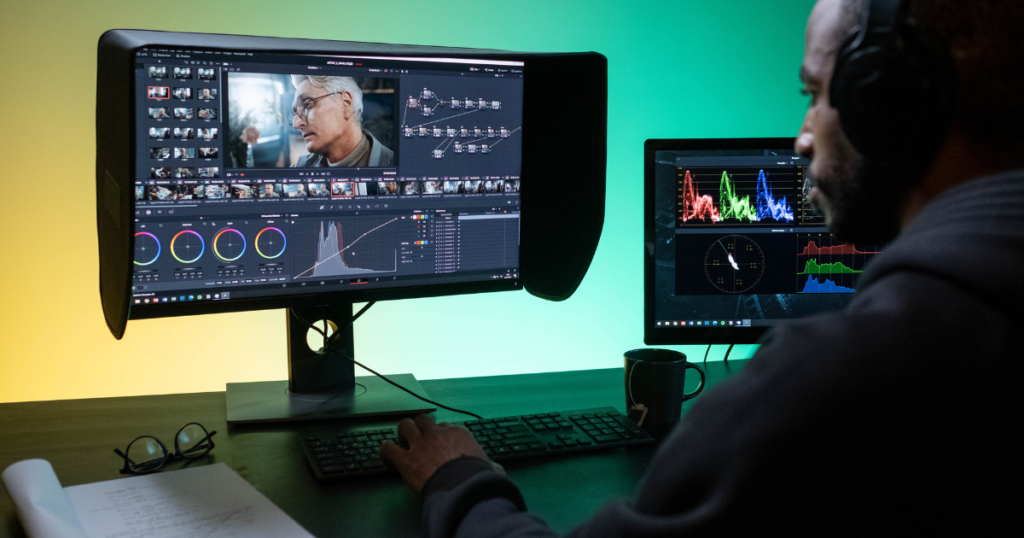Audio editing software refers to digital tools that allow users to manipulate and modify audio recordings. These software programs provide a wide range of features for tasks such as recording, editing, mixing, and enhancing audio files. They are commonly used in various fields, including music production, podcasting, film and video production, sound design, and more.
What to consider when choosing the best audio editing software
When choosing the best audio editing software, several factors should be taken into consideration to ensure it meets your specific needs and preferences:
1. Features and Capabilities:
Look for software that offers a comprehensive set of editing tools, including cutting, copying, pasting, fading, time-stretching, pitch-shifting, noise reduction, and more.
Consider features such as multitrack editing, which allows you to work with multiple audio tracks simultaneously, essential for complex projects.
2. User Interface (UI) and Ease of Use:
The software’s interface should be intuitive and user-friendly. A cluttered or complex interface can hinder your workflow and make the learning curve steep.
Some software offers customizable interfaces, which can be beneficial if you have specific preferences or a preferred workflow.
3. Compatibility:
Ensure that the software is compatible with your operating system (Windows, macOS, Linux, etc.)
Look for software that supports a variety of audio file formats to prevent compatibility issues when importing/exporting audio files.
4. Supported Plugins and Virtual Instruments:
Many audio editing software programs support third-party plugins and virtual instruments. This allows you to enhance the software’s capabilities by adding effects, processors and sounds from other developers.
5. Audio Quality and Processing:
Check whether the software supports high-quality audio processing and can handle different sample rates and bit depths.
Look for features like real-time audio effects processing to hear changes as you make them.
6. Workflow and Productivity:
Consider the software’s workflow and how well it fits with your creative process. Some software offers streamlined workflows for specific tasks like vocal tuning, music composition, or podcast production.
Keyboard shortcuts and customizable macros can greatly speed up your editing process.
7. Price and Licensing:
Audio editing software comes in a range of price points, from free options to high-end professional suites. Consider your budget and the features you need before making a decision.
Some software offers subscription models, while others have one-time purchase options. Choose what aligns with your preferences.
8. Community and Support:
Look for software with an active user community, as this can be a valuable resource for troubleshooting, learning, and sharing tips and techniques.
Good customer support, including tutorials, documentation, and responsive assistance, is important, especially for beginners.
9. Updates and Future Development:
Check the software’s update history and the developer’s reputation for consistent updates and improvements. This ensures that your chosen software will remain relevant and compatible with evolving technologies.
10. Trial Versions and Demos:
Whenever possible, try out trial versions or demos of the software to get a firsthand experience of its features and workflow. This helps you make an informed decision based on your preferences.
Remember that the “best” audio editing software can vary depending on your specific needs. Whether you’re a beginner or a professional, considering these factors will help you select the software that aligns with your creative goals and technical requirements.
List of 13 Audio Editing Software for Business:
1. Adobe Audition
2. Audacity
3. Steinberg Cubase
4. Avid Pro Tools
5. Logic Pro X
6. Ableton Live
7. Reaper
8. Presonus Studio One
9. Cakewalk by BandLab
10. FL Studio
11. GarageBand
12. MAGIX Samplitude
13. WavePad
What are the best audio editing software?
1. Adobe Audition
Adobe Audition is a powerful and widely used audio editing software that caters to the needs of businesses across various industries. With its robust features and intuitive interface, it’s a go-to choice for professionals seeking top-notch audio editing capabilities. Here’s why Adobe Audition stands out:
Multitrack Editing
Adobe Audition supports multitrack editing, allowing businesses to work on complex projects with multiple audio elements seamlessly. This is crucial for tasks like podcast production, voiceovers, and music composition.
Realtime Effects
The software provides real-time audio effects processing, enabling users to hear the changes they make in real time. This feature is valuable for making quick adjustments and ensuring the desired outcome.
Noise Reduction and Restoration
For businesses that require high-quality audio, Adobe Audition offers advanced noise reduction and audio restoration tools. This is beneficial for cleaning up recordings and ensuring professional audio quality.
Integration with Adobe Creative Cloud
If your business already utilizes Adobe Creative Cloud applications, Audition seamlessly integrates with other Adobe software, streamlining your workflow and allowing for easy interchange of assets.
Batch Processing
Businesses often deal with large volumes of audio files. Adobe Audition facilitates batch processing, which helps save time by applying edits and effects to multiple files simultaneously.
Customizable UI and Workspaces
The software allows users to customize the user interface and create personalized workspaces. This is advantageous for tailoring the software to specific business needs and individual preferences.
Incorporating Adobe Audition into your business’s audio production workflow can significantly enhance the quality and efficiency of your projects. From audio editing to podcast production and sound design, Adobe Audition provides the tools and features necessary for professional results.
2. Audacity
Audacity is a popular open-source audio editing software that is well suited for businesses looking for a free and versatile solution. Despite being free, Audacity offers a range of features that can benefit various business needs:
CrossPlatform Compatibility: Audacity is available for Windows, macOS, and Linux, making it a versatile choice for businesses with diverse operating systems.
Multitrack Editing: While not as robust as some paid software, Audacity does offer multitrack editing capabilities, allowing businesses to work with different audio elements simultaneously.
Effects and Plugins: Audacity supports a wide range of audio effects and can incorporate third-party plugins, expanding its functionality and catering to specific business requirements.
Simple Interface: The user interface of Audacity is straightforward to navigate. This makes it an excellent choice for businesses that require basic audio editing without the complexities of more advanced software.
Recording and Editing: Audacity not only allows businesses to edit existing audio files but also provides recording capabilities. This is useful for creating original content such as podcasts, webinars, and voiceovers.
Educational Resources: Audacity’s popularity has led to a wealth of online tutorials and resources. This is advantageous for businesses with team members who may be new to audio editing.
Audacity’s combination of price (free) and features makes it an attractive choice for startups, small businesses, and projects with budget constraints. It may not have all the bells and whistles of premium software, but it can certainly meet the needs of businesses seeking basic to intermediate audio editing capabilities.
3. Steinberg Cubase
Steinberg Cubase is a comprehensive audio production software designed for professional use. Businesses in the music industry, postproduction, and multimedia sectors can benefit from its advanced features and capabilities:
Music Production: Cubase is renowned for its music production capabilities, making it a favorite among recording studios, composers, and music producers. It offers a wide array of virtual instruments, MIDI sequencing, and notation tools.
Audio Recording and Editing: Businesses can rely on Cubase for high quality audio recording and editing. It supports multitrack recording and offers advanced audio manipulation tools.
MIDI Capabilities: Cubase’s powerful MIDI capabilities are essential for businesses that work extensively with virtual instruments and electronic music production. It provides precise control over MIDI data.
Mixing and Effects: With a range of built-in effects and third-party plugin compatibility, Cubase is equipped for mixing and audio processing. It allows for detailed control over audio levels, panning, and automation.
Scoring and Notation: For businesses involved in media scoring and soundtrack composition, Cubase’s notation tools enable the creation of sheet music and musical scores.
Collaboration: Cubase supports collaboration through features like cloud-based storage and project sharing, facilitating teamwork on audio projects even across different locations.
Cubase’s reputation as a professional-grade audio production platform is well-deserved. Its feature-rich environment, tailored for music composition and production, positions it as an excellent choice for businesses that require high-end audio capabilities.
4. Avid Pro Tools
Avid Pro Tools is considered the industry standard in audio production and is widely used in professional recording studios, postproduction houses, and the entertainment industry. Here’s why Pro Tools is a top choice for businesses:
Unmatched ProLevel Features: Pro Tools offers an extensive set of features tailored to professional audio production, including advanced audio editing, mixing, MIDI sequencing, and virtual instrument integration.
Industry Compatibility: Many recording studios, film production houses, and music professionals use Pro Tools. This compatibility is valuable for businesses that need to collaborate with industry peers.
Scalability: Pro Tools is available in different versions, allowing businesses to choose the level of functionality that suits their needs and budgets, from entry-level to full-fledged professional suites.
Collaboration Features: Pro Tools Cloud Collaboration enables real-time collaborative work on projects, even across different locations. This is vital for businesses with remote teams.
High-Quality Mixing and Effects: Pro Tools boasts a wide array of high-quality plugins and effects, providing businesses with the tools needed to achieve polished and professional audio results.
Audio PostProduction: For businesses involved in postproduction for film, TV, and other media, Pro Tools offers features like ADR (Automatic Dialogue Replacement) and Foley recording, making it an indispensable tool.
Reliability and Stability: Pro Tools is known for its stability and reliability, crucial for businesses that can’t afford technical glitches or crashes during critical audio projects.
Businesses that require the utmost in audio production quality and demand compatibility with industry standards often turn to Avid Pro Tools. Its robust capabilities and reputation make it a top choice for professionals.
5. Logic Pro X
Logic Pro X is an Apple-exclusive audio production software catering to businesses in music production, sound design, and multimedia. Its features and integration with macOS make it a prime choice for Macbased businesses:
Music Production Excellence: Logic Pro X is known for its advanced music production features, offering a vast library of virtual instruments, MIDI sequencing, and audio recording capabilities.
Mac Integration: As a macOS exclusive software, Logic Pro X integrates seamlessly with other Apple applications and services, providing a cohesive workflow for Mac-based businesses.
Professional Mixing Tools: The software offers an impressive set of mixing tools, including a wide variety of plugins and effects, enabling businesses to achieve polished audio mixes.
Sound Library: Logic Pro X comes with an extensive library of loops, samples, and presets, facilitating quick creative ideas and inspiration for music and sound projects.
Film and Media Soundtracks: Businesses involved in media production can benefit from Logic Pro X’s scoring and soundtrack capabilities, making it a valuable asset for film and video projects.
Smart Tempo: Logic Pro X’s Smart Tempo feature is particularly useful for businesses working with projects that involve multiple tempos or time signatures, ensuring audio elements sync seamlessly.
Logic Pro X is a powerhouse for Cloud-based businesses, offering a complete set of audio production tools with a user-friendly interface and deep integration into the macOS ecosystem.
6. Ableton Live
Ableton Live is a unique and innovative audio software known for its creative approach to music production and performance. Businesses that value experimentation and real-time performance can benefit from its features:
Live Performance Focus: Ableton Live is renowned for its live performance capabilities, making it an ideal choice for businesses involved in electronic music, DJing, and live shows.
Session and Arrangement Views: The software’s dual view system allows businesses to work in both a session-based and arrangement-based environment, providing flexibility for different workflows.
Realtime Effects and Instrument Manipulation: Live’s unique audio warping features enable real-time manipulation of audio clips, making it perfect for businesses that need to experiment and create on the fly.
MIDI Integration: Ableton Live’s intuitive MIDI mapping and integration with MIDI controllers are beneficial for businesses that rely heavily on MIDI instruments and controllers.
Creative Sound Design: Live’s integration of audio effects, virtual instruments, and Max for Live, an extended toolkit for customization and sound design, encourages creative experimentation.
Looping and Remixing: For businesses involved in remixing and loop-based composition, Live’s capabilities facilitate quick arrangement and manipulation of audio loops.
Ableton Live’s emphasis on creative and real-time music production makes it a valuable tool for businesses that seek to push boundaries and explore new sonic territories.
7. Reaper
Reaper is an affordable and highly customizable audio software that suits a wide range of business needs. Its flexibility and comprehensive feature set make it an attractive option:
CostEffective: Reaper offers a low-cost licensing model, which is ideal for businesses looking for a powerful audio editing solution without breaking the bank.
Customizable Interface: Reaper’s user interface can be customized extensively, allowing businesses to tailor the software to their specific workflows and preferences.
Vast Plugin Support: The software supports a wide variety of third-party plugins, enabling businesses to expand its functionality according to their audio processing needs.
MultiTrack Recording and Editing: Reaper supports multitrack recording and editing, making it suitable for businesses that require the ability to work with multiple audio elements simultaneously.
Stability and Performance: Despite its affordability, Reaper is known for its stability and performance, making it reliable for businesses working on critical audio projects.
Regular Updates: Reaper’s development team is active in releasing updates and improvements, ensuring that businesses have access to new features and bug fixes.
Reaper’s combination of affordability, customizability, and comprehensive features makes it a versatile audio editing solution for businesses of varying sizes and industries.
8. Presonus Studio
Presonus Studio One is a user-friendly audio software that offers professional-level features while maintaining an intuitive interface. Businesses seeking a balance between functionality and ease of use can benefit from Studio One:
Single Window Workspace: Studio One’s single-window workspace streamlines the audio production process, allowing businesses to focus on creativity rather than navigating through multiple windows.
DragandDrop Functionality: The software emphasizes drag and drop functionality for quick arranging and editing of audio clips, beneficial for businesses that need efficient workflows.
Integrated Virtual Instruments: Studio One comes with a range of integrated virtual instruments, reducing the need for external plugins and simplifying the music creation process.
Project Collaboration: Studio One supports cloud-based project collaboration, enabling businesses to work together on audio projects, even when team members are in different locations.
Automation and Effects: The software provides robust automation capabilities and a variety of built-in effects, empowering businesses to achieve professional-level audio quality.
Melodyne Integration: Studio One’s seamless integration with Melodyne, a renowned pitch correction and audio editing tool, enhances its capabilities for businesses involved in vocal production.
Presonus Studio One’s user-friendly interface and feature-rich environment make it an excellent choice for businesses that value ease of use without compromising on audio production quality.
9. Cakewalk
Cakewalk by BandLab is a professional audio software tailored for Windows users. Its powerful features and integration with BandLab’s online platform make it a valuable asset for businesses:
Advanced Audio Editing: Cakewalk offers a wide range of advanced audio editing tools, including multitrack editing, MIDI sequencing, and virtual instrument integration.
ProChannel Effects: The software features ProChannel, a customizable channel strip with integrated EQ, compression, and other effects, allowing for detailed audio processing.
VST Support: Cakewalk supports a variety of VST plugins, enabling businesses to expand the software’s capabilities with third-party effects and instruments.
Loop Construction: For businesses engaged in loop-based music production, Cakewalk’s Loop Construction View facilitates quick arrangement and manipulation of audio loops.
Collaboration through BandLab: Cakewalk is integrated with the BandLab online platform, enabling seamless project sharing and collaboration with team members and clients.
Music Notation: Businesses that require music notation capabilities can benefit from Cakewalk’s integrated notation tools, making it suitable for scoring and composition.
Cakewalk by BandLab’s professional-grade features and compatibility with Windows systems make it a solid choice for businesses seeking a comprehensive audio production solution.
10. FL Studio
FL Studio (formerly known as FruityLoops) is a popular choice among electronic music producers and businesses involved in electronic music production. Its unique approach and features cater to creative and experimental projects:
Pattern-Based Workflow: FL Studio’s pattern-based workflow is well-suited for businesses focused on electronic music production and remixing, allowing for quick arrangement and experimentation.
Step Sequencer: The software’s step sequencer is particularly useful for creating intricate drum patterns, basslines, and other rhythmic elements commonly found in electronic music.
Virtual Instruments: FL Studio comes with a variety of virtual instruments tailored for electronic music, including synthesizers and samplers, enabling businesses to create unique sounds.
RealTime Effects: Businesses can apply real-time effects to audio and MIDI tracks, allowing for on-the-fly sound manipulation and creative experimentation.
VST Support: FL Studio supports VST plugins, giving businesses access to a wide range of third party effects, processors, and instruments to enhance their productions.
Automation and Control: FL Studio’s automation capabilities and MIDI control options are essential for businesses that rely heavily on dynamic and evolving soundscapes.
FL Studio’s focus on electronic music production and its unique approach to arranging and composition make it a valuable tool for businesses in the electronic music genre.
11. GarageBand
GarageBand is an entry-level audio software exclusively available for macOS users. While it may be considered a beginner-friendly tool, it offers a surprising amount of functionality for businesses with basic audio needs:
Mac Integration: Being an Apple application, GarageBand seamlessly integrates with other macOS applications and services, providing a cohesive ecosystem for Mac-based businesses.
UserFriendly Interface: GarageBand’s user interface is designed to be intuitive, making it suitable for businesses that are new to audio editing and production.
Virtual Instruments and Loops: The software comes with a variety of virtual instruments and prerecorded loops, enabling businesses to create music and audio content without extensive experience.
Podcast Production: GarageBand includes features tailored for podcast production, making it a suitable choice for businesses entering the world of podcasting.
Simple Audio Recording: For businesses that primarily require basic audio recording and editing, GarageBand offers a straightforward and easy-to-use platform.
Music Creation: While it may not have the advanced features of other professional software, GarageBand still allows businesses to create music and experiment with different sounds.
GarageBand is an excellent starting point for businesses that are new to audio editing and production. Its Mac integration and user-friendly interface make it accessible for teams looking to dip their toes into audio content creation.
12. MAGIX Samplitude
MAGIX Samplitude is a comprehensive audio software that caters to businesses requiring professional level audio production tools. Its feature set covers a wide range of audio needs:
Multitrack Recording and Editing: Samplitude supports multitrack recording and editing, allowing businesses to work with multiple audio tracks and elements simultaneously.
Advanced Mixing and Effects: The software offers a variety of mixing tools and built-in effects, providing businesses with the resources needed for precise audio processing.
Scoring and MIDI: For businesses involved in media scoring or music composition, Samplitude’s notation and MIDI capabilities make it a valuable asset.
VST Compatibility: Samplitude supports VST plugins, allowing businesses to expand the software’s functionality with third-party effects and virtual instruments.
Automation and Control: Businesses can take advantage of Samplitude’s automation capabilities and MIDI control options for dynamic audio manipulation.
Audio Restoration and Mastering: Samplitude’s advanced audio restoration and mastering tools are valuable for businesses seeking to enhance the quality of their audio content.
MAGIX Samplitude’s well-rounded feature set and professional-grade capabilities position it as a suitable choice for businesses that require a comprehensive audio production solution.
13. WavePad
WavePad is a versatile audio editing software that caters to a wide range of business needs. Its simplicity and range of features make it suitable for businesses seeking an efficient and capable audio editing solution:
UserFriendly Interface: WavePad boasts a user-friendly interface, making it accessible for businesses that prioritize ease of use.
Basic to Advanced Editing: Whether businesses require basic audio editing or more advanced manipulation, WavePad provides tools for cutting, copying, pasting, and applying effects.
Multitrack Editing: WavePad supports multitrack editing, enabling businesses to work on projects involving multiple audio elements.
Sound Effects Library: The software includes a sound effects library, providing businesses with a collection of prerecorded audio clips to enhance their projects.
Batch Processing: WavePad’s batch processing feature is valuable for businesses that deal with a large number of audio files, allowing for efficient editing of multiple files at once.
Wide Format Support: WavePad supports a variety of audio formats, ensuring compatibility when importing and exporting audio files.
WavePad’s balance of features and user-friendly interface makes it a versatile choice for businesses of varying sizes and industries that need efficient audio editing capabilities.
Key takeaway points
In the modern business landscape, audio editing software plays a pivotal role in enhancing audio content across industries ranging from music production to podcasting and multimedia.
The choice of software depends on factors such as functionality, user interface, compatibility, and budget. Whether businesses require professional audio processing, intuitive user experiences, or specialized tools, the diverse range of options available ensures that there’s an ideal solution for every need.
By leveraging the capabilities of the best audio editing software, businesses can elevate their audio projects to new heights and deliver outstanding content to their audiences.
FAQ: Best Audio Editing Software
1. What is the best audio editing software for professionals?
Adobe Audition is highly regarded among professionals for its comprehensive features, real-time effects, noise reduction tools, and integration with Adobe Creative Cloud, making it an ideal choice for businesses seeking top-tier audio production capabilities.
2. Which audio editing software is best for beginners on a budget?
Audacity is a great option for beginners as it’s open-source, free, and offers a simple interface. It’s suitable for businesses that need basic audio editing without the complexity of more advanced software.
3. What audio editing software is best for music production?
Steinberg Cubase is tailored for music production with its MIDI sequencing, virtual instruments, and mixing capabilities. It’s favored by music producers, composers, and recording studios for its comprehensive music-oriented features.
4. Which audio editing software is best for electronic music production?
FL Studio (FruityLoops) is a popular choice for electronic music producers due to its pattern-based workflow, step sequencer, virtual instruments, and real-time effects that facilitate creative experimentation.
5. What software is suitable for collaborative audio projects?
Avid Pro Tools offers Cloud Collaboration features, enabling real-time collaborative work on projects, making it a valuable tool for businesses with remote teams or collaborative projects.
6. What audio editing software is best for Mac users?
Logic Pro X is a powerful and versatile audio editing software exclusive to macOS. Its integration with other Apple applications and services makes it an excellent choice for Mac-based businesses.
7. Which software is affordable yet feature-rich?
Reaper stands out as a cost-effective solution with extensive customization options and compatibility with third-party plugins. It’s suitable for businesses seeking professional features on a budget.
8. What software is ideal for podcast production?
Adobe Audition and Audacity are popular choices for podcast production. Adobe Audition offers advanced features, real-time effects, and noise-reduction tools, while Audacity provides a free and user-friendly platform for basic podcast editing.
9. Which audio editing software is suitable for live performances?
Ableton Live is renowned for its live performance capabilities, making it an ideal choice for businesses involved in electronic music, DJing, and live shows. Its real-time effects and creative features cater to dynamic live performances.
10. What software is best for businesses with remote teams?
Presonus Studio One and Cakewalk by BandLab offer features for cloud-based project collaboration, enabling teams to work together on audio projects, even when team members are in different locations.
11. What software is recommended for creative sound design?
Ableton Live’s integration of effects, virtual instruments, and real-time manipulation features make it an excellent choice for businesses engaged in creative sound design and experimentation.
12. Which software is suitable for businesses focused on audio restoration?
MAGIX Samplitude and WavePad offer advanced audio restoration tools for businesses seeking to enhance audio quality and restore older recordings to their former glory.
13. Can I use free software for professional audio editing?
While free software like Audacity offers essential audio editing capabilities, professional-grade software like Adobe Audition and Avid Pro Tools provides more advanced features, better integration, and enhanced audio quality for businesses aiming for professional results.
14. How do I choose the best audio editing software for my business?
Consider factors such as your business’s industry, workflow, budget, and required features. Evaluate software based on its compatibility with your operating system, audio quality, user interface, and capabilities like multitrack editing, real-time effects, and collaboration features.
15. Are there trial versions or demos available for this software?
Many audio editing software providers offer trial versions or demos that allow you to explore the software’s features before committing. This can help you determine if the software meets your business’s specific needs before purchasing a full license.





